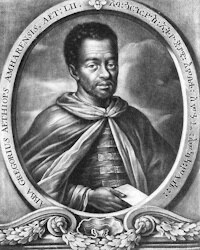Abba Gorgoryos (1595-1658)

Abba Gorgoryos is well known in history due to his encounter with Hiob Ludolf. This meeting with the then young German scholar took place in Rome in 1649, where the Ethiopian lived together with a few other monks. They were all refugees who had fled their country following the persecution that was proclaimed on Catholics when Fasil became the Emperor of Ethiopia in 1632. The foreigners were expelled. The Ethiopian Catholics were given a choice between converting back to the Ethiopian Orthodox Church or leaving the country. If they decided to stay without abandoning the Catholic faith, they would face execution. Hence, they chose flight.
The young Ludolf, who worked at the Swedish embassy in Paris after completing his university studies, was given a mission to go to Rome in 1649 to work for a few months in the Vatican archives. While there, the young German sought out the Ethiopian monks in order to deepen his knowledge of Ethiopia and of its classical language, Ge’ez. He met Abba Gorgoryos with whom he established a good relationship; the Ethiopian helped the German deepen and refine his knowledge of the Ge’ez language. After he returned to Paris, Ludolf continued his relations with Gorgoryos. Finally, the young scholar got financial assistance from Ernest I, Duke of Saxe-Gotha that enabled him to invite Gorgoryos to Gotha in 1652. Gorgoryoas assisted Hiob Ludolf in his research and writing on Ethiopian studies, including in the writing of his seminal work Historia Aethiopica as well as an Amharic-Latin dictionary, which became the first African language to be translated to Latin, and a Ge'ez lexicon. The Ethiopian savant provided Ludolf with access to rare and valuable manuscripts, which helped the latter to develop a more accurate understanding of Ethiopian history and culture. The insights into Ethiopian culture and language that he got from Gorgoryos were invaluable to Ludolf, who relied on the Ethiopian for guidance and advice. Without Abba Gorgoryos's help, it is impossible that Ludolf would have been able to produce such a comprehensive work on Ethiopia.
On his return journey to Ethiopia in 1658, he died in a shipwreck in the Mediterranean Sea off the port of Aleppo, in present day Syria.
400th anniversary of Hiob Ludolf
Abba Gorgoryos (1595 - 1658)
Hiob Ludolf (1624 - 1704)
Research area
Abba Daniel Assefa
Prof. Shiferaw Bekele
Prof. Sebsebe Demissew
Short Bio of the researchers
A glimpse into the symposium
Introduction to exhibition